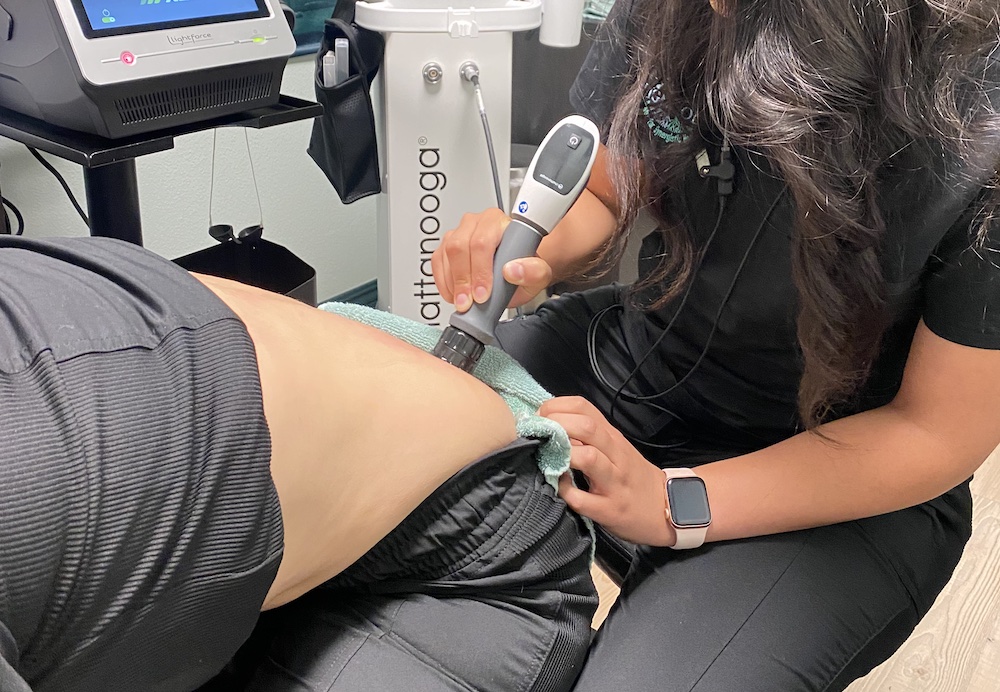If you're experiencing discomfort in your upper back, I want to share how targeted adjustments can be a beneficial solution for you. As a chiropractor, I utilize specific techniques designed to realign your spine, which can significantly reduce tension and pain in that area. These adjustments not only help improve your posture but also contribute to your overall health and well-being.
But the benefits don't stop with adjustments alone. I also want to introduce you to effective stretching techniques and ergonomic practices that can further enhance your relief. It's important to understand how to incorporate these methods into your daily routine for lasting results. By gaining a comprehensive understanding of chiropractic care and natural healing, you can take proactive steps toward achieving the comfort you deserve. I'm here to guide you on this journey!
Understanding Upper Back Discomfort
As a local chiropractor, I want to help you understand the common causes of upper back discomfort and how we can address them naturally. Many individuals experience this nagging pain without realizing that it often stems from factors like poor posture, prolonged sitting, or muscle strain. You may find yourself hunched over your computer or looking down at your phone, and before you know it, that discomfort becomes a regular part of your life.
The upper back, which includes the upper thoracic spine, plays a vital role in supporting your head and shoulders. Each time you lean forward or twist in an awkward position, you're adding extra strain to the muscles and joints in this area. It's important to recognize that muscle tension is a primary contributor to upper back discomfort.
Sitting for long periods can lead to tight, fatigued muscles, resulting in soreness and stiffness that can limit your range of motion, making it hard to turn your head or reach for items. Stress can also worsen this tension, causing you to unconsciously tighten your shoulders and upper back.
Beyond muscle issues, your spinal alignment is crucial for your overall comfort. When your spine is out of alignment due to daily habits or past injuries, it can lead to discomfort that may radiate down your back or even into your arms.
Understanding these factors is the first step toward alleviating your discomfort. As your chiropractor, I'm here to guide you through natural healing methods to improve your spinal health and overall well-being. Together, we can work on restoring balance and alleviating pain so you can feel your best.
Benefits of Chiropractic Adjustments
As a local chiropractor, I want to take a moment to educate you on the incredible benefits chiropractic adjustments can provide, especially when it comes to alleviating upper back discomfort and enhancing your overall well-being.
When you visit our clinic, my focus is on realigning your spine to improve how your body functions. This realignment can significantly reduce pain and tension in your upper back, helping you to move more freely and comfortably in your daily life.
One of the most remarkable aspects of chiropractic adjustments is the immediate relief many of my patients experience. By addressing misalignments in the spine, we can alleviate pressure on nerves and muscles, leading to a noticeable reduction in discomfort.
Often, after just a few sessions, patients report that their upper back feels more relaxed, making everyday activities much more manageable.
But chiropractic care isn't just about targeting pain; it also plays a crucial role in promoting better posture. Many of us struggle with poor posture, which can be a significant contributor to upper back discomfort.
Through regular adjustments, we can help you maintain a more aligned spine, which in turn reduces the strain on your muscles and ligaments, helping to prevent future pain and discomfort.
Furthermore, chiropractic adjustments can enhance your overall health by improving the function of your nervous system. When your spine is correctly aligned, your nervous system can communicate with your body more effectively.
Many of my patients notice improvements in their energy levels, better sleep quality, and even a boost in immune function.
In summary, incorporating chiropractic adjustments into your routine can provide you with both immediate relief and long-term health benefits.
I encourage you to consider chiropractic care as a valuable option for managing upper back discomfort. Together, we can embrace the power of natural healing and make a positive difference in your well-being.
Effective Stretching Techniques
As a chiropractor dedicated to helping patients achieve optimal health, I want to emphasize the importance of incorporating effective stretching techniques into your daily routine, especially if you're experiencing upper back discomfort. Stretching is a natural way to improve flexibility, alleviate muscle tension, and enhance blood circulation to the upper back, which can significantly support your healing process. Here are some valuable stretches that I recommend.
One of the first stretches to consider is the cat-cow stretch. To perform this, start on all fours with your wrists directly beneath your shoulders and your knees under your hips. As you inhale, arch your back gently while lifting your head and tailbone (this is the cow position). Then, exhale and round your spine, tucking your chin to your chest (the cat position). Repeat this sequence several times; it's a wonderful way to release built-up tension in your back.
Next, let's talk about the upper back stretch. Whether you're standing or sitting, keep your posture tall and interlace your fingers. Extend your arms straight in front of you, and as you round your upper back, push your hands away from your body. Hold this position for 15-30 seconds; you should feel a nice stretch between your shoulder blades.
Another beneficial stretch is the doorway stretch. Stand in a doorway and bend your arms at 90 degrees, placing your forearms against the door frame. Step forward with one foot, allowing yourself to feel the stretch across your chest and shoulders. Hold this stretch for 15-30 seconds before switching to the other side to ensure balanced relief.
Lastly, I encourage the seated twist. Sit upright in a chair and keep your back straight. Place your right hand on the back of the chair and gently twist your torso to the right, holding this position for 15-30 seconds. Then, repeat on the left side. This stretch can help release tightness in your upper back and improve spinal mobility.
Ergonomic Tips for Daily Relief
As a local chiropractor dedicated to helping you achieve optimal health, I want to share some valuable ergonomic practices that can significantly alleviate upper back discomfort. Many people are unaware of how small adjustments in their daily routines can lead to remarkable improvements in their well-being. Here are some essential tips to help you start feeling better:
- Adjust Your Workspace: It's crucial for your chair to provide support for your lower back, and your computer screen should be positioned at eye level. Make sure your feet rest flat on the floor or on a footrest. This simple adjustment can greatly enhance your posture and reduce strain on your back.
- Use Proper Lifting Techniques: When lifting heavy objects, remember to bend your knees and keep the load close to your body. Avoid twisting your back; instead, pivot on your feet to change direction. This technique helps prevent injuries and protects your spine.
- Take Regular Breaks: I encourage you to set a timer to remind yourself to stand up and stretch every 30-60 minutes. Moving around not only promotes blood flow but also helps reduce stiffness in your upper back, allowing you to feel more relaxed and comfortable throughout the day.
- Practice Good Posture: Whether you're sitting or standing, it's important to keep your shoulders relaxed and your spine straight. Engaging your core muscles can provide additional support to your upper back and help maintain proper alignment.
By incorporating these ergonomic tips into your daily life, you can experience significant relief from upper back discomfort.
Don't underestimate the impact of a well-structured environment and conscious habits. Prioritizing ergonomics is a step toward a healthier, more comfortable lifestyle. I encourage you to make these adjustments today—your body will thank you for it!
If you have any questions or need further guidance, feel free to reach out. Your journey to better health starts here!
Creating a Consistent Routine
Establishing a consistent routine is essential for effectively managing upper back discomfort, and I'd like to share some practical steps you can incorporate into your daily life to promote better posture, flexibility, and overall back health.
First, I recommend setting aside dedicated time each day for stretching and strengthening exercises. Just 10 to 15 minutes can significantly impact your well-being. Focus on movements that specifically target the muscles surrounding your upper back, such as shoulder shrugs, chest openers, and thoracic rotations. These exercises can help alleviate tension and improve mobility.
Next, be mindful of your posture throughout the day. Whether you're seated at a desk or standing while preparing meals, it's crucial to keep your shoulders back and your spine properly aligned. I suggest setting hourly reminders to check in on your posture. This simple habit can make a huge difference in preventing discomfort.
It's also important to integrate regular breaks into your routine. If you tend to sit for long periods, aim to take short breaks every 30 minutes. Stand up, walk around, and stretch. This practice can help relieve built-up tension and prevent discomfort from escalating.
In addition to physical exercises, consider incorporating relaxation techniques, such as deep breathing or mindfulness meditation, into your daily routine. These practices can help reduce stress, which often contributes to muscle tension and discomfort in the upper back.
Lastly, I encourage you to document your progress. Keeping a journal of the exercises and stretches you perform, as well as any discomfort you experience, can provide valuable insights. This will allow you to identify which methods work best for you and adjust your routine accordingly.
By committing to these practices, you can create a sustainable routine that significantly alleviates upper back discomfort and enhances your overall quality of life.
If you have any questions or need further guidance, feel free to reach out during your next visit. Your journey to better back health is important, and we're here to support you every step of the way.
Conclusion
As your local chiropractor, I want to share how incorporating targeted adjustments into your daily routine can significantly alleviate upper back discomfort. Many of my patients are surprised to learn about the numerous benefits of chiropractic care. By receiving regular adjustments, you can help realign your spine, which is crucial for your overall health.
In addition to chiropractic treatments, I encourage you to practice effective stretching techniques at home. Stretching can enhance flexibility and reduce tension in your upper back, making a world of difference in how you feel. Furthermore, adopting ergonomic habits in your daily life—whether at work or at home—can prevent discomfort from returning.
I urge you to commit to a consistent routine that includes these practices. Not only will you find relief from pain, but you'll also notice improvements in your mobility and posture. Taking charge of your health is essential, and with chiropractic care, you can enjoy a more comfortable and active lifestyle, free from the burden of upper back discomfort. Let's work together on this journey to better health!



